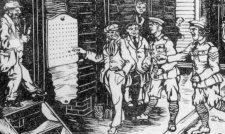
The last Tally
It would appear that all camps allocated a local number on arrival to all internees - for both Douglas and Knockaloe, and probably all other camps, this number was issued sequentially in order of arrival. Except for a few long-resident resident Germans on the Island who had not naturalized, both Douglas and Knockaloe were camps that received internees from other camps, thus any dates of internment at either camp will be after an often considerable time spent interned elsewhere. Unlike Douglas the admissions register for Knockaloe has not survived thus any such camp numbers must be obtained from other sources - for Knockaloe these include the surviving Letter Books (3 out of probably some 20), the single surviving Camp Orders Book and the various Government papers that were not destroyed - all these are held by the Manx Museum, other sources include the various camp newspapers many of which are online, together with other documents in private hands. Some prisoners could aquire two or more camp numbers those who were sent to Civilian estatblishments such as Douglas or Liverpool (Walton) prisons, the Lunatic Asylum at Union Mills or Noble's Hospital in Douglas or Temporary Parole elsewhere were classed as struck off the Camp strength and would gain a new internee number on any re-admittance to the camp. The lists sent to the International Red Cross at Geneva also provide a major source of information.
These camp numbers were stamped on brass tally discs held by each internee to show identity - for morning roll calls they were required to exit the hut and hang their tally on a board carried by the compound sergeant - an illustration of this use is shown in a depiction of camp life by internee F Nettel entitled the Last Tally [taken from an illustration in "Living with the Wire"]

The last Tally
According to Hartmann's account of the School system set up in the camp from early 1915, these tally boards resided in a part of one hut set aside for the compound sergeant and men who kept order within each compound - it was these rooms that Hartmann would have liked to use as school rooms hence his barbed comment that the guards did not look on with any favour towards these efforts toward education.
The iMuseum has gathered a considerable list of internees from a list transcribed by the Anglo-German Family History Society which derive from lists of repatriated internees indicated as from Koblenz in any reference - these quote a Knockaloe or Douglas camp number which bears no relationship whatsoever to the actual internee number used by these camps, nor to any internment date, but are the serial number allocated by the PoWIB. There is also another query with these lists in that they claim many were transferred enroute to repatriation to a Nibley camp (Nibley is near Yate near Bristol which did have an internment camp) though surviving records would indicate a transfer to Ripon which is convenient for Hull and postwar ferries to Germany - the dates of such transfers however agree with these other records.
Besides the admissions register Knockaloe also kept a register of daily arrivals and departures which has survived and whose structure is discussed elsewhere. Given the assumption of sequential numbering of internees as they entered under camp control then it would appear straightforward, albeit tedious, to keep a tally of such arrivals and derive an internee number or in the case of the large group arrivals a range of numbers into which that of any specific internee should fall. The considerable number of internees struck off strength and gaining a new internee number on any re-admittance to the camp can provide some reference points - the sole surviving Camp Orders Book which covers the final few months of the camp includes many examples of such allocated numbers -the highest number so allocated in September 1919 just prior to camp closure was 34936. This exercise has been tried, the derived numbers track the relatively few whose true camp numbers and arrival dates are known, which after allowing for a couple of clerical errors (e.g. wrong column entries) the derived and known numbers differ by at most 30 but usually nearer 10 - there may be some further entry errors still be be found but it would appear that the derived numbers may be used to indicate the arrival date to within a few days or better. If so then as the arrival register for arrivals post 5th October 1915 (or camp number 20980) generally indicates from where they arrived, it can also provide their previous place of internment.
Manx Museum MS 09310 - includes the Camp Letter books and a Camp Orders Book
Living with the Wire: Civilian Internment in the Isle of Man during the the two world wars Douglas: Manx National
Heritage, 2nd Ed 2010
|
|
||
|
|
||
| Any comments, errors or omissions gratefully received The
Editor HTML Transcription © F.Coakley , 2018 |
||